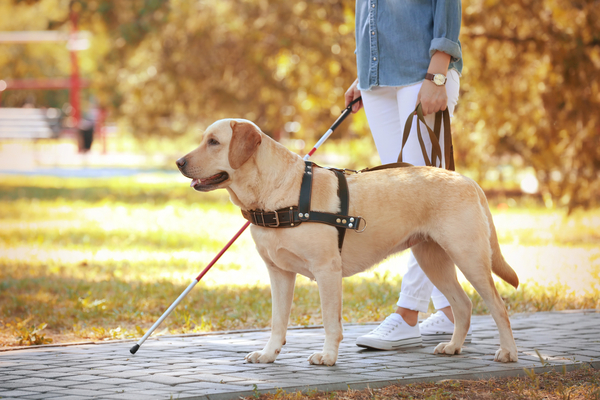Since before World War II, guide dogs have been utilized worldwide. Dorothy Harrison Eustis, an American dog breeder residing in Switzerland, wrote about a guide dog program in Potsdam, Germany, in 1927. The article, about dogs being taught to be ears and eyes for German World War I veterans, was featured in “The Saturday Evening Post,” where a man named Morris Frank, blind since childhood but now an insurance salesman and college student enrolled at Vanderbilt University in the Roaring 20’s, heard about it.
Frank sent a letter to Eustis as soon as he became aware the story, imploring her to train a dog for him. Eustis agreed to Frank’s urgent plea and welcomed him to Switzerland. He wrote, “Thousands of blind like me abhor being dependent on others. Help me and I will help them. Train me and I will bring back my dog and show people here how a blind man can be absolutely on his own.”
After a time of training with two dogs, Eustis and Frank picked the best dog for the job, whom Frank named Buddy. In 1928, Frank arrived in New York City, where he and Buddy were met by a swarm of media. Buddy turned out to be fantastic at navigating Frank through the congested NYC streets full of traffic and people. When Frank arrived home safely, he wrote a success message to Eustis to express his happiness.
Frank said: “I shall never forget the next three minutes: 10-ton trucks rocketing past, cabs blowing their horns in our ears, drivers shouting at us. When we finally made it to the other side and I realized what an amazing job she had done, I leaned over and gave Buddy a great big hug and told her what a good, good girl she was.”
The Seeing-Eye was started on January 29, 1929, with Frank and Eustis as co-founders. To this day, the Seeing-Eye is the world’s most sustainable guide dog training school. The Seeing-Eye Guide Dog Anniversary celebrates the Seeing-Eye’s inception date as the year’s anniversary. Many people’s lives are becoming more stable due to guide dogs, and many governmental policies for people who need guide dogs.
Buddy and her significant role in history has been remembered in a tome co-authored by her human, First Lady of the Seeing Eye, as well as in the children’s books Dog Diaries #2: Buddy and Morris and Buddy: The Story of the First Seeing Eye Dog. A made-for-TV movie in the 1980s, Love leads the Way: A True Story, also told their tale, while in the city of Morristown, New Jersey a statue stands which captures the special bond between Morris Frank and Buddy, the dog who gave the gift of self-reliance.
The Seeing Eye is the oldest guide dog school in the world. This non-profit school breed, raise, and trains German shepherds, Labrador retrievers, golden retrievers (and other breeds) to guide people who are blind and visually impaired. Thanks to “The Seeing Eye” and other organizations like it, training methods, as well as laws, are improving so that their impairment doesn’t limit individuals with seeing-eye dogs.
And in their 95 years, they have also trained dogs to assist in more things than just being a seeing-eye dog. Some examples include mobile assistance dogs, which help people who have trouble getting around due to cerebral palsy, severe arthritis, or other conditions. “Mobility assistance dogs can be trained to do things such as push an elevator button, open and close doors, and even pick up car keys and credit cards off of the ground,” said Dr. Blue-McLendon.
They also have hearing dogs, which help the hearing impaired by responding to sound with specific behavior. For instance, when they hear a knock at the front door, they might be taught to sit in front of the person to alert them.
Another type of service dog that has recently become popular is PTSD dogs, or “emotional support dogs.” These animals are taught a wide variety of skills to assist people suffering from post-traumatic stress disorders and are often aids to our military veterans. All support dogs, regardless of their specialty, go through vigorous training to learn and perfect the skills needed to aid their human.
Thanks to the generosity of their supporters, the fee The Seeing Eye charge their students has remained unchanged since the 1930s — $150 for their first Seeing Eye dog or $50 for a replacement dog. Military veterans are only charged $1.
You can help too! You can donate to the Seeing Eye by doing a one-time gift or monthly. It’s the gift of mobility and independence to those in need!
—
Photo Credit: Africa Studio / Shutterstock.com
